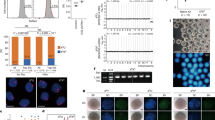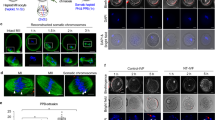Abstract
A reliable nuclear transfer method was first reported in 1983; it provided definite evidence that parthenogenetic embryos are lethal at early postimplantation in mammals. Subsequently, nuclear transfer has been extensively used as an important and versatile tool for investigating embryo and somatic-cell cloning and nucleo-cytoplasmic interactions. Further development of this technique has enabled the generation of bimaternal embryos containing two haploid sets of maternal genomes from female germ cells of different origins. By using a 2-d nuclear transfer system for oocyte reconstruction, viable mice can be produced solely from maternal genomes, without the participation of the paternal genome. This oocyte reconstruction system, as described in this protocol, could provide valuable guidelines for exploring the potential endowments of gametes and for conferring novel properties to them.
This is a preview of subscription content, access via your institution
Access options
Subscribe to this journal
Receive 12 print issues and online access
$259.00 per year
only $21.58 per issue
Buy this article
- Purchase on Springer Link
- Instant access to full article PDF
Prices may be subject to local taxes which are calculated during checkout







Similar content being viewed by others
References
Nagy, A., Gertsenstein, M., Vintersten, K. & Behringer, R. Manipulating the Mouse Embryo: A Laboratory Manual (Cold Spring Harbor Laboratory Press, New York, 2003).
Hajkova, P. et al. Epigenetic reprogramming in mouse primordial germ cells. Mech. Dev. 117, 15–23 (2002).
Surani, M.A., Hayashi, K. & Hajkova, P. Genetic and epigenetic regulators of pluripotency. Cell 128, 747–762 (2007).
Lee, J. et al. Erasing genomic imprinting memory in mouse clone embryos produced from day 11.5 primordial germ cells. Development 129, 1807–1817 (2002).
Mann, J.R. Imprinting in the germ line. Stem Cells 19, 287–294 (2001).
Obata, Y., Kono, T. & Hatada, I. Gene silencing: maturation of mouse fetal germ cells in vitro. Nature 418, 497 (2002).
Kaneda, M. et al. Essential role for de novo DNA methyltransferase Dnmt3a in paternal and maternal imprinting. Nature 429, 900–903 (2004).
Lucifero, D., Mann, M.R., Bartolomei, M.S. & Trasler, J.M. Gene-specific timing and epigenetic memory in oocyte imprinting. Hum. Mol. Genet. 13, 839–849 (2004).
Li, E., Sucov, H.M., Lee, K.F., Evans, R.M. & Jaenisch, R. Normal development and growth of mice carrying a targeted disruption of the alpha 1 retinoic acid receptor gene. Proc. Natl. Acad. Sci. USA 90, 1590–1594 (1993).
Feil, R., Walter, J., Allen, N.D. & Reik, W. Developmental control of allelic methylation in the imprinted mouse Igf2 and H19 genes. Development 120, 2933–2943 (1994).
Thorvaldsen, J.L., Duran, K.L. & Bartolomei, M.S. Deletion of the H19 differentially methylated domain results in loss of imprinted expression of H19 and Igf2. Genes Dev. 12, 3693–3702 (1998).
Surani, M.A. Germ cells: the eternal link between generations. C R Biol. 330, 474–478 (2007).
Okano, M., Bell, D.W., Haber, D.A. & Li, E. DNA methyltransferases Dnmt3a and Dnmt3b are essential for de novo methylation and mammalian development. Cell 99, 247–257 (1999).
Aoki, A. et al. Enzymatic properties of de novo-type mouse DNA (cytosine-5) methyltransferases. Nucleic Acids Res. 29, 3506–3512 (2001).
Lin, I.G., Han, L., Taghva, A., O'Brien, L.E. & Hsieh, C.L. Murine de novo methyltransferase Dnmt3a demonstrates strand asymmetry and site preference in the methylation of DNA in vitro. Mol. Cell Biol. 22, 704–723 (2002).
Hata, K., Okano, M., Lei, H. & Li, E. Dnmt3L cooperates with the Dnmt3 family of de novo DNA methyltransferases to establish maternal imprints in mice. Development 129, 1983–1993 (2002).
Chedin, F., Lieber, M.R. & Hsieh, C.L. The DNA methyltransferase-like protein DNMT3L stimulates de novo methylation by Dnmt3a. Proc. Natl. Acad. Sci. USA 99, 16916–16921 (2002).
Bao, S. et al. Nuclear competence for maturation and pronuclear formation in mouse oocytes. Hum. Reprod. 17, 1311–1316 (2002).
Eppig, J.J., Schultz, R.M., O'Brien, M. & Chesnel, F. Relationship between the developmental programs controlling nuclear and cytoplasmic maturation of mouse oocytes. Dev. Biol. 164, 1–9 (1994).
Kono, T., Obata, Y., Yoshimzu, T., Nakahara, T. & Carroll, J. Epigenetic modifications during oocyte growth correlates with extended parthenogenetic development in the mouse. Nat. Genet. 13, 91–94 (1996).
Obata, Y. et al. Disruption of primary imprinting during oocyte growth leads to the modified expression of imprinted genes during embryogenesis. Development 125, 1553–1560 (1998).
Kono, T., Sotomaru, Y., Katsuzawa, Y. & Dandolo, L. Mouse parthenogenetic embryos with monoallelic H19 expression can develop to day 17.5 of gestation. Dev. Biol. 243, 294–300 (2002).
Kono, T. et al. Birth of parthenogenetic mice that can develop to adulthood. Nature 428, 860–864 (2004).
Kawahara, M., Wu, Q., Yaguchi, Y., Ferguson-Smith, A.C. & Kono, T. Complementary roles of genes regulated by two paternally methylated imprinted regions on chromosomes 7 and 12 in mouse placentation. Hum. Mol. Genet. 15, 2869–2879 (2006).
Kawahara, M. et al. High-frequency generation of viable mice from engineered bi-maternal embryos. Nat. Biotechnol. 25, 1045–1050 (2007).
Kawahara, M., Wu, Q., Ferguson-Smith, A.C. & Kono, T. Appropriate expression of imprinted genes on mouse chromosome 12 extends development of bi-maternal embryos to term. FEBS Lett. 581, 5178–5184 (2007).
Kono, T. Genomic imprinting is a barrier to parthenogenesis in mammals. Cytogenet. Genome Res. 113, 31–35 (2006).
Wu, Q. et al. Regulated expression of two sets of paternally imprinted genes is necessary for mouse parthenogenetic development to term. Reproduction 131, 481–488 (2006).
Bao, S. et al. Development of bovine oocytes reconstructed with a nucleus from growing stage oocytes after fertilization in vitro. Theriogenology 59, 1231–1239 (2003).
Niwa, K. et al. Nuclei of oocytes derived from mouse parthenogenetic embryos are competent to support development to term. Biol. Reprod. 71, 1560–1567 (2004).
Takeuchi, T., Gong, J., Veeck, L.L., Rosenwaks, Z. & Palermo, G.D. Preliminary findings in germinal vesicle transplantation of immature human oocytes. Hum. Reprod. 16, 730–736 (2001).
Palermo, G.D., Takeuchi, T. & Rosenwaks, Z. Technical approaches to correction of oocyte aneuploidy. Hum. Reprod. 17, 2165–2173 (2002).
Author information
Authors and Affiliations
Corresponding author
Rights and permissions
About this article
Cite this article
Kawahara, M., Obata, Y., Sotomaru, Y. et al. Protocol for the production of viable bimaternal mouse embryos. Nat Protoc 3, 197–209 (2008). https://doi.org/10.1038/nprot.2007.531
Published:
Issue Date:
DOI: https://doi.org/10.1038/nprot.2007.531
This article is cited by
-
Preimplantation death of xenomitochondrial mouse embryo harbouring bovine mitochondria
Scientific Reports (2015)
Comments
By submitting a comment you agree to abide by our Terms and Community Guidelines. If you find something abusive or that does not comply with our terms or guidelines please flag it as inappropriate.



